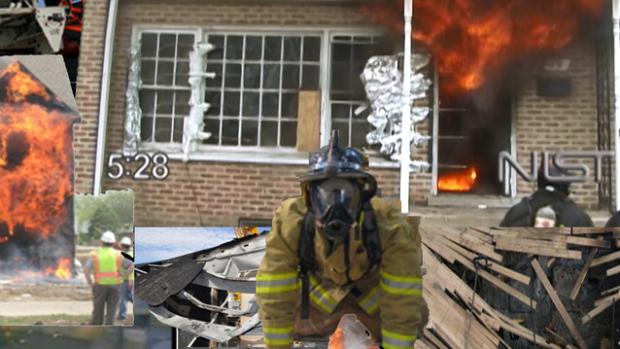New Training Tool Helps Firefighters Stay ALIVE
NYU-Poly Researchers Join Government and Fire Departments to Develop Free Game-Based Online Education for Newly Emerging Risks

Brooklyn, N.Y.—A free online training tool is being introduced nationwide to firefighters who are facing new building construction and housing materials that make fires more dangerous.
Researchers at the Polytechnic Institute of New York University (NYU-Poly) created the unique game-based computer program to educate, train, and disseminate critical information to both career and volunteer squads. Advanced Learning through Integrated Visual Environments (ALIVE) features short, interactive training modules that incorporate game techniques and simulate the real-time critical decision-making process. Applications for mobile devices are also available for download.
Since its inception, ALIVE has been adopted as a training tool by more than 50 fire departments that encompass more than 25,000 firefighters, including those from New York City and Chicago—two of the largest departments in nation.
ALIVE was funded by the U.S. Department of Homeland Security (DHS) and led by NYU-Poly in partnership with the Fire Department of New York (FDNY), the Chicago Fire Department (CFD), and the fire departments of Bloomington, Eden Prairie, and Eagan, Minnesota. Tests of 600 firefighters determined that individuals who trained using ALIVE scored consistently higher than those who received classroom training.
“We were stunned that the firefighters did so much better with ALIVE than in the classroom – it is rare that results are this strong and consistent,” said NYU-Poly Professor of Environmental Psychology Richard Wener, one of the leaders of the research project.
Teaching firefighters solely through traditional means is a laborsome and costly process, tedious for both trainers and firefighters.
Working through the interactive ALIVE segments, firefighters learn more than just how to fight a fire: They learn the science behind the fires. Achieving an understanding of fire dynamics is of paramount importance to today’s firefighters since the characteristics of modern residential construction—including large, open layouts, increased fuel loads from synthetic materials and furnishings, and minimal fire resistance of structural components—make modern residential fires far different from those of past generations.
“Many factors contribute to the significant number of deaths and injuries, but perhaps most troubling is the fact that many firefighters were likely not aware of advancements in firefighting methods that could have changed these tragic outcomes,” said Prabodh Panindre, senior research scientist at NYU-Poly.
“By gaining a better understanding of modern fire behavior through the use of interactive ALIVE training, firefighters are able to adapt more effectively to today's hazardous fire environment, thereby improving their health and safety,” said James Dalton, coordinator in the Office of Research and Development at the Chicago Fire Department.
It normally takes years for modern fire dynamics research to jump from research journals into everyday practice. However, ALIVE presents cutting-edge firefighting tactics directly to the firefighters who can implement them immediately, and reduce the risk of injury and death.
Two modules of ALIVE, “Wind-Driven High-Rise Fires” and “Fires in Residential Lightweight Construction,” have been released to the nationwide firefighter community free of charge. The iOS and Android versions of this training are also available at engineering.nyu.edu/fire. Volunteer firefighters, who often hold other full-time jobs, can access the program on their personal computers, tablets, or smart phones whenever they like, repeating each module at their convenience until they absorb it.
“More than 70 percent of firefighters nationwide are volunteers. Until now, a scientifically tested and proven effective tool that can rapidly disseminate new firefighting interventions to all volunteer firefighters at no cost simply did not exist,” said Bloomington Fire Chief Ulysses (Ulie) Seal.
ALIVE research leader Sunil Kumar, professor of mechanical engineering at NYU-Poly and dean of engineering at NYU Abu Dhabi, explained other efficiencies: “By way of example, the Fire Department of New York City is so large that it would take an entire year and several million dollars to have every member take just one full day of classroom training. Using ALIVE as an ancillary training tool can result in enormous acceleration of the training schedule as well as significant cost savings.” He continued, “Those cost savings are far from the most important benefit of using ALIVE. ALIVE allows speedy dissemination of knowledge to fire departments big and small, to those with substantial training budgets or none, and offers a mechanism for the rapid training of new interventions to the fire community across the nation.”
“If we do not train, we will not be good at what we do; for firefighters, that can be deadly,” FDNY Captain Erik Smith said. The modular format of this training allows firefighters to pause and resume training at their convenience. If a call comes in during training, firefighters would be able to respond and then pick up where they left off upon their return. If necessary, they can review earlier sections and repeat what they don’t understand. Unlike classroom training, users can repeat the training as many times as they desire without incurring the staffing cost of additional instructor hours. This convenience allows users to train until they are comfortable with the material, leaving more classroom time for equipment demonstrations and questions.




